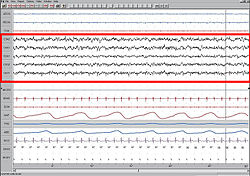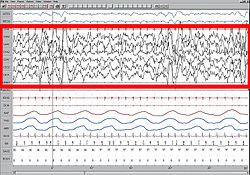- Non-rapid eye movement sleep
-
"slow eyes" redirects here. For sloe eyes, see Prunus spinosa.
Non-rapid eye movement, or NREM is, collectively, sleep stages 1 – 3, previously known as stages 1 – 4. Rapid eye movement sleep (REM) is not included. There are distinct electroencephalographic and other characteristics seen in each stage. Unlike REM sleep, there is usually little or no eye movement during this stage. Dreaming is rare during NREM sleep, and muscles are not paralyzed as in REM sleep. In addition, there is a parasympathetic dominance during NREM.[1]
Contents
Stages of NREM sleep
NREM sleep was divided into four stages in the Rechtschaffen and Kales (R&K) standardization of 1968. That has been reduced to three in the 2007 update by The American Academy of Sleep Medicine (AASM).[2]
- Stage 1 – occurs mostly in the beginning of sleep, with slow eye movement. Alpha waves disappear and the theta wave appears. People aroused from this stage often believe that they have been fully awake. During the transition into stage 1 sleep, it is common to experience hypnic jerks.
- Stage 2 – no eye movement occurs, and dreaming is very rare. The sleeper is quite easily awakened. EEG recordings tend to show characteristic "sleep spindles" and "K-complexes" during this stage.
- Stage 3 – previously divided into stages 3 and 4, is deep sleep, slow-wave sleep (SWS). Stage 3 was formerly the transition between stage 2 and stage 4 where delta waves, associated with "deep" sleep, began to occur, while delta waves dominated in stage 4. In 2007, these were combined into just stage 3 for all of deep sleep.[3] Dreaming is more common in this stage than in other stages of NREM sleep though not as common as in REM sleep. The content of SWS dreams tends to be disconnected, less vivid, and less memorable than those that occur during REM sleep.[4] This is also the stage during which parasomnias most commonly occur.
Polysomnography
Polysomnography (PSG) is a test used in the study of sleep; the test result is called a polysomnogram. Below are images of the NREM stages 1, 2 and 4 (prior to the merging of stages 3 and 4).
The figures represent 30-second epochs (30 seconds of data). They represent data from both eyes, chin, EEG, legs, microphone, intercostal EMG, sternocleidomastoid activity, nasal/oral air flow, thoracic effort, abdominal effort, EKG, oxymetry, and body position, in that order. EEG is highlighted by the red box. Sleep spindles in the stage 2 figure are underlined in red.
Slow-wave sleep
Slow-wave sleep (SWS) is made up of the deepest stage of NREM, and is often referred to as deep sleep.
The highest arousal thresholds (e.g. difficulty of awakening, such as by a sound of a particular volume) are observed in stage 3. A person will typically feel groggy when awoken from this stage, and indeed, cognitive tests administered after awakening from stage 3 indicate that mental performance is somewhat impaired for periods up to 30 minutes or so, relative to awakenings from other stages. This phenomenon has been called "sleep inertia."
After sleep deprivation there is usually a sharp rebound of SWS, suggesting there is a "need" for this stage. The major factor determining how much slow-wave sleep is observed in a given sleep period is the duration of preceding wakefulness.[citation needed]
References
- ^ Andreasen, Nancy C.; Black, Donald W. (2006). Introductory Textbook of Psychiatry. American Psychiatric. ISBN 1585622729.
- ^ Schulz, Hartmut (2008). "Rethinking sleep analysis. Comment on the AASM Manual for the Scoring of Sleep and Associated Events". J Clin Sleep Med (American Academy of Sleep Medicine) 4 (2): 99–103. PMC 2335403. PMID 18468306. http://www.pubmedcentral.nih.gov/articlerender.fcgi?tool=pmcentrez&artid=2335403.
- ^ "Glossary. A resource from the Division of Sleep Medicine at Harvard Medical School, Produced in partnership with WGBH Educational Foundation". Harvard University. 2008. http://healthysleep.med.harvard.edu/glossary/n-p. Retrieved 2009-03-11. "The 1968 categorization of the combined Sleep Stages 3–4 was reclassified in 2007 as Stage N3."
- ^ McNamara, P.; McLaren, D.; Durso, K. (June 2007). "Representation of the Self in REM and NREM Dreams". Dreaming 17 (2): 113–126. doi:10.1037/1053-0797.17.2.113. PMC 2629609. PMID 19169371. http://www.pubmedcentral.nih.gov/articlerender.fcgi?tool=pmcentrez&artid=2629609.
Further reading
- Rechtschaffen, A; Kales, A (1968). A Manual of Standardized Terminology, Techniques and Scoring System For Sleep Stages of Human Subjects. US Dept of Health, Education, and Welfare; National Institutes of Health.
- M. Massimini, G. Tononi, et al., "Breakdown of Cortical Effective Connectivity During Sleep," Science, vol. 309, 2005, pp. 2228–32.
- P. Cicogna, V. Natale, M. Occhionero, and M. Bosinelli, "Slow Wave and REM Sleep Mentation," Sleep Research Online, vol. 3, no. 2, 2000, pp. 67–72.
- D. Foulkes et al., "Ego Functions and Dreaming During Sleep Onset," in Charles Tart, ed., Altered States of Consciousness, p. 75.
- Rock, Andrea (2004). The Mind at Night. ISBN 0738207551.
- Warren, Jeff (2007). "The Slow Wave". The Head Trip: Adventures on the Wheel of Consciousness. ISBN 978-0679314080.
- Iber, C; Ancoli-Israel, S; Chesson, A; Quan, SF. for the American Academy of Sleep Medicine. The AASM Manual for the Scoring of Sleep and Associated Events: Rules, Terminology and Technical Specifications. Westchester: American Academy of Sleep Medicine; 2007.
Categories:- Dreaming
- Sleep physiology
Wikimedia Foundation. 2010.



